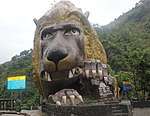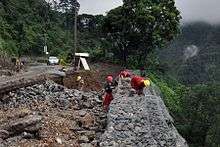Kennon Road
Kennon Road, also known as Rosario–Baguio Road, is a two lane 33.53-kilometer (20.83 mi) roadway in Benguet province in the Philippines connecting the mountain city of Baguio to the lowland town of Rosario in La Union province. The project begun in 1903 and opened for travel on January 29, 1905. Originally called Benguet Road,[1] it was later renamed in honor of its builder, Col. Lyman Walter Vere Kennon of the U.S. Army Corps of Engineers. It is the second oldest road that leads to Baguio, after Naguilian Road (now known as Quirino Highway), and the shortest route to Baguio for travelers from Manila and provinces in central and southern Luzon.[2]
| |
|---|---|
| Benguet Road Rosario–Baguio Road | |
 Kennon Road as viewed from the Kennon Road Viewdeck | |
| Route information | |
| Maintained by Department of Public Works and Highways La Union 2nd District Engineering Office Benguet 1st District Engineering Office Baguio City District Engineering Office | |
| Length | 33.5 km (20.8 mi) |
| Component highways | |
| Restrictions |
|
| Major junctions | |
| North end | |
| |
| South end | |
| Location | |
| Provinces | Benguet, La Union |
| Major cities | Baguio |
| Towns | Rosario, Tuba |
| Highway system | |
| |
The entire road forms part of National Route 54 (N54) of the Philippine highway network.
Route description

Coming from the lowlands, Kennon Road is one of the three major access roads that lead to the highland city of Baguio.[3] The upward climb reveals a picturesque view of the mountains, lush vegetation, and pine trees as one gets closer to the city.
Most of the highway's stretch encompasses the municipality of Tuba in the province of Benguet.[4] The small settlements along the road, known as Camps 1 to 8, were originally established for the pioneer builders of the road,[1] but have been occupied since by local residents. The Bued River flows along a rocky canyon from the lofty heights, and following this course the road was cut above the river bed.
The highway is a toll road,[3][5] with the lower tollgate located about 2.5 kilometres (1.6 mi) from the junction at Rosario near Camp 1. The upper tollgate is about 13 kilometres (8.1 mi) south of Baguio near the Lion's Head and Camp 6, in Tuba.

The steepest portion of the road between Camp 6 and Camp 7 in Baguio is commonly known as "Zigzag Road" because of the numerous switchbacks required. The design of the road switchbacks along that section of the road are similar in construction to the agricultural rice terraces found locally in Benguet and the other mountain provinces of the Cordillera Administrative Region.
History

_(14786316433).jpg)
The construction of the road commenced in 1903 by cutting across the mountains of Benguet with the combined efforts of Filipinos, Americans, Filipino-Chinese and Japanese nationals. It was considered one of the most difficult and expensive civil engineering projects of its day, with expenditures by the newly established Insular Government of the Philippine Islands in excess of US$2.7 million.[6]
More than 2,300 foreign and local workers worked on the road. Aside from Filipino engineers and construction workers and U.S. Army Corps of Engineers headed by Col. Lyman Kennon, foreigners from 36 countries were recruited to work on the road; the majority, at about 1,500 or 22%, were Japanese.[7] Hundreds of workers died from malaria while more plunged to their deaths while building the road. After the road was completed, some of the foreign road workers decided to remain in Baguio to live permanently.[2]
The original road was a Macadam Telford-type road which was later improved into an all-weather asphalt roadway. More recently, some portions of Kennon Road have been replaced with concrete pavement.[8]
The highway was severely damaged by the 1990 Luzon earthquake[3] that the Department of Public Works and Highways decided for the permanent closure of the road.[9] The highway was proposed to be replaced by a road traversing through the town of Itogon on the way to the lowlands of San Manuel, but was met with criticism from the inhabitants of Baguio. Kennon Road was reopened for public use in September 1, 1991 after rehabilitation efforts were completed.[9]
On August 2018, the road was closed temporarily to traffic due to road repairs. However, on December 17, 2018, the alternative route to Baguio, which is Asin–Nangalisan–San Pascual Road, had opened to all motorists. The road reopened on November 29, 2019 to all motorists.
Road hazards

Kennon Road is one of the most hazardous roads in the Philippines,[11] especially during rainy seasons, when road accidents are common. The road is closed during heavy rains or typhoon conditions to avoid casualties from landslides[11] [12] [13] [14]
Portions of the highway are also prone to land-sinking, particularly along Barangay Camp 3 in Tuba.[15]
Although Kennon is the shortest of the four major access roads, travel time is frequently as long as the other two because of poor road conditions. It usually takes an experienced commuter from 45 minutes to an hour to negotiate the 41.2-kilometre (25.6 mi) steep and winding climb by car.
Seasoned locals, race car drivers and motorsports enthusiasts, due to better road conditions, are now completing the drive under 30 to 25 minutes. [8]
Intersections
Intersections are numbered by kilometer posts, with Rizal Park in Manila designated as kilometer zero.
| Region | Province | City/Municipality[lower-alpha 1] | km[lower-alpha 1] | mi | Destinations | Notes |
|---|---|---|---|---|---|---|
| Ilocos Region | La Union | Rosario | 214.613 | 133.354 | Southern terminus | |
| Rosario toll plaza | ||||||
| Ilocos Region–CAR boundary | La Union–Benguet boundary | Rosario–Tuba boundary | 215.155– 215.158 | 133.691– 133.693 | La Union 2nd District Engineering Office–Benguet 1st Engineering Office highway boundary | |
| Cordillera Administrative Region | Benguet | Tuba | Camp 1 Bridge 1 over Bued River | |||
| Colorado Bridge | ||||||
| 227.038 | 141.075 | Ampasit Bridge | ||||
| 227.784 | 141.538 | Camp 3 Bridge 2 | ||||
| Ataki Bridge | ||||||
| Camp 4 Bridge 1 over Bued River | ||||||
| 231.127 | 143.616 | Camp 4 Bridge 2 | ||||
| Pugo Bridge over Bued River | ||||||
| 232.259 | 144.319 | Maramal Bridge over Bued River | ||||
| Camp 4 Bridge 4 | ||||||
| 233.358 | 145.002 | Camp 4 Bridge 5 | ||||
| Camp 5 Bridge 1 | ||||||
| 235.465 | 146.311 | Camp 5 Bridge 2 | ||||
| 237.940 | 147.849 | Camp 6 Bridge | ||||
| Demonstration Bridge over Basa Creek | ||||||
| Baguio toll plaza | ||||||
| Benguet–Baguio boundary | 239.593– 240.899 | 148.876– 149.688 | Benguet 1st District Engineering Office–Baguio City Engineering Office highway boundary. Lion's Head. | |||
| Baguio | 245.158 | 152.334 | ||||
| 246.550 | 153.199 | |||||
| Military Cut-off Road | ||||||
| 248.147 | 154.191 | Roundabout. Northern terminus. | ||||
1.000 mi = 1.609 km; 1.000 km = 0.621 mi
| ||||||
Future
When opened on July 15, 2020, the 88.5-kilometer-long Tarlac–Pangasinan–La Union Expressway will connect Kennon Road to the Subic–Clark–Tarlac Expressway via the MacArthur Highway and North Luzon Expressway, which will cut travel time to the mountain city from Metro Manila by three to four hours.[19][20]
Notes
References
- Kennon, Lyman. "Kennon's own report on the famous zig–zag". Baguio Midland Courier. Retrieved 30 September 2014.
- Bankoff, Greg. (2005). These brothers of ours: Poblete's obreros and the road to Baguio 1903–1905. Journal of Social History - Volume 38, Number 4, Summer 2005, pp. 1047-1072 PDF at University of Auckland
- "Kennon Road". City of Pines. Retrieved 30 September 2014.
- "Kennon Rd" (Map). Mapcentral. Retrieved 30 September 2014.
- Montecillo, Paolo (14 March 2012). "Hike in toll on Kennon Road looms". Philippine Daily Inquirer. Retrieved 30 September 2014.
- "Baguio City Centennial September 1, 1909". Balita Pinoy. Retrieved 1 December 2010.
- Afable, Patricia (2008). "Compelling Memories and Telling Archival Documents and Photographs: The Search for the Baguio Japanese Community" (PDF). Asian Studies. 44 (1).
- CityofPines.com - Kennon Road
- Cabreza, Vincent (16 May 2012). "Fighting for century-old Kennon Road". Philippine Daily Inquirer. Retrieved 5 October 2014.
- Cawis, Redjie Melvic (10 June 2016). "DPWH advises motorists to avoid Kennon Road due to rehab works". Philippine Information Agency. Retrieved 3 September 2016.
- "Kennon Road". Dangerous Roads. Retrieved 30 September 2014.
- "Rains trigger landslide along Kennon Road in Benguet". GMA News. 2010-04-30. Retrieved 30 September 2014.
- Locsin, Joel (15 September 2014). "Kennon Road closed, 11 roads impassable due to landslides caused by Luis". GMA News. Retrieved 30 September 2014.
- "1 killed in Benguet landslide; Kennon Road closed". GMA News. 12 August 2013. Retrieved 30 September 2014.
- Arthur, Allad-iw (26 August 2014). "Residents of sinking Kennon Road village urged to move to safer ground". Northern Dispatch (InterAksyon). Retrieved 30 September 2014.
- "La Union 2nd". 2016 DPWH Atlas. Department of Public Works and Highways. Retrieved May 22, 2016.
- "Benguet 1st". 2016 DPWH Atlas. Department of Public Works and Highways. Retrieved May 22, 2016.
- "Baguio City". 2016 DPWH Atlas. Department of Public Works and Highways. Retrieved May 22, 2016.
- See, Dexter (18 December 2011). "Kennon road rehab to spur Cordillera's economic growth". Baguio Midland Courier. Retrieved 5 October 2014.
- Unite, Betheena (June 23, 2020). "Pozorrubio to Rosario Section of TPLEX to open by July 15". Manila Bulletin. Retrieved July 2, 2020.
.svg.png)